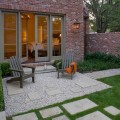Add Vertical Impact to Formal Gardens
Climbing vines add vertical impact to formal gardens. On larger estates this is very important. If a yard is very large, a large garden may appear to low to the landscape without some type of vertical element to give it an extra dimension. Smaller gardens often need a vertical element in order to avoid looking insignificant due to their size. A number of architectural elements work very well with formal garden designs that serve as ready environments where vines can grow and thrive.
A basic arch covered with vines can be a doorway to a small formal garden. Arches have been a part of classical designs since ancient times. Not all formal gardening constitutes what we would call a classical garden in the historical since. However, formal softscape features a love for symmetry rooted in classical forms. The vertical impact of an arch is even more profound when covered with plant life.
Pergolas lend vertical impact to a formal garden by introducing what amounts to an outdoor room. Although the structure does not have solid walls or even a solid ceiling, it definitely constitutes a very comfortable form of shelter. Climbing vines are integral to the function of pergolas because they fill in the gaps between the latticework that create the walls. They also grow along the roof beams to fill in the spaces here. What results is dappled light that gently falls into the interior. The leaves of the vines absorb the rest of the light and most of the heat. This makes the interior significantly cooler than the air in the surrounding garden.
Climbing vines are also integral to the aesthetic of a garden pergola. Can you imagine a pergola that is nothing but wood lattice and cross beams for a roof? Such a structure would be an eyesore, to say the least. Vines make the entire structure appear so alive that from a distance it actually looks like a part of the garden that rose up in the form of a structure made for human comfort. In a sense it very much represents the ultimate intention of professional landscaping design, which is to create outdoor living environments where activities and relaxation can be pursued as readily as they can be indoors.
Both small gazebos and large gazebos can be enhanced by climbing vines. It is not uncommon, in fact, to use vines that bloom with brightly colored flowers as a way of ornamenting the color of a wooden gazebo. If a gazebo is very basic in its design, one way to really enhance it is to cover it with vegetation. Vegetation also has the effect of softening architecture to some extent. You can have a very functional, sophisticated structure constructed that still looks very organic because of the vines that grow over its frame.
It does require the assistance of a trained professional to know which types of climbing vines will work best with a particular style of formal garden. A French garden, for instance, uses nothing but varying shades of green in the form of shrubs and trees. Vines here should compliment a color scheme based on green. On the other hand, formal English gardens rely on color for their success. Vines here should continue the basic color schemes of the ground cover along the full axis of vertical impact.

